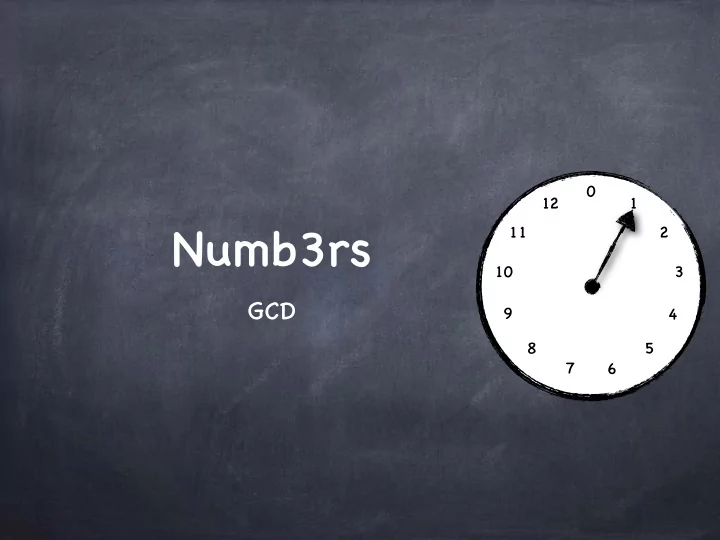

0 12 1 Numb3rs 11 2 10 3 GCD 9 4 8 5 7 6
The Skippy Clock 0 12 1 Has 13 hours on its dial! 11 2 Needle moves two hours at a time 10 3 Which all numbers will the needle 9 4 reach? 8 5 7 6 Reaches all of them!
Divisibility Definition: For n,d ∈ Z , d|n (d divides n) if ∃ q ∈ Z n = qd d|n ≡ n is a multiple of d ≡ d is a divisor of n a.k.a. a factor -12 -6 -4 -3 -2 -1 1 2 3 4 6 12 -24 -12 0 12 24 e.g. Multiples(12) = { …, -24, -12, 0, 12, 24, … }. e.g. Divisors(12) = { ±1, ±2, ±3, ±4, ±6, ±12 }. Divisors(0) = Z [ ∀ d ∈ Z d|0]. Multiples(0) = {0} [ ∀ n ∈ Z 0|n ↔ n=0]
Common Factors Common Divisor: m is a common divisor of integers a and b if m|a and m|b. [a.k.a. common factor] Greatest Common Divisor ( for (a,b) ≠ (0,0) ) gcd(a,b) = largest among common divisors of a and b Well-defined: 1 is always a common factor. And, no common factor is larger than min(|a|,|b|) (unless a=0 or b=0; see below). Then, gcd(a,b) is an integer in the range [1, min(|a|,|b|)]. e.g. Divisors(12) = { ±1, ±2, ±3, ±4, ±6, ±12 }. Divisors(18) = { ±1, ±2, ±3, ±6, ±9, ±18 }. Common-divisors(12,18) = { ±1, ±2, ±3, ±6 }. gcd(12,18) = 6 e.g. If a|b and (a,b) ≠ (0,0), then gcd(a,b)=|a|. In particular, ∀ a ≠ 0 gcd(a,0) = |a|
GCD as Tiling [Here all numbers are positive integers] d is a common factor of a & b, iff a d x d square tile can be used to perfectly tile an a x b rectangle 4 GCD: largest such square 8 tile 12
Common Factors Common Divisor: c is a common divisor of integers a and b if c|a and c|b. [a.k.a. common factor] Greatest Common Divisor ( for (a,b) ≠ (0,0) ) gcd(a,b) = largest among common divisors of a and b ∀ a,b,n ∈ Z , common-divisors(a,b) = common-divisors(a,b+na) i.e., (x|a ∧ x|b) ⟷ (x|a ∧ x|b+na). [Verify!] Hence, ∀ a,b,n ∈ Z , gcd(a,b) = gcd(a,b+na) In particular, ∀ a,b ∈ Z , gcd(a,b) = gcd(a,r), where b = aq+r and 0 ≤ r < a
Euclid’ s GCD Algorithm [Here all numbers are positive integers] Find the largest square perfectly tiling a x b rectangle common-divisors(a,b) = common-divisors(a,b-a) gcd(a,b) = gcd(a,b-a) 6 10 16 gcd(6,16) = gcd(6,10)
Euclid’ s GCD Algorithm [Here all numbers are positive integers] Find the largest square perfectly tiling a x b rectangle common-divisors(a,b) = common-divisors(a,b-qa) gcd(a,b) = gcd(a,b-qa) 6 ∀ a,b ∈ Z 2 ∃ u,v ∈ Z gcd(a,b) = 4 16 u ⋅ a + v ⋅ b 3 ⋅ 6 - 1 ⋅ 16 = 6 - (16-2 ⋅ 6) = 6 - 4 = 2 gcd(6,16) = gcd(6,4) = gcd(2,4) = 2
The Hoppy Bunny A bunny is sitting on an infinite number line, at position 0 The bunny has two hops — of lengths a and b, where a,b ∈ Z Can hop to left or right (irrespective of the sign of a,b) What all points can the bunny reach? After u a-hops and v b-hops (u, v could be negative, indicating direction opposite a or b’ s sign), bunny is at a ⋅ u + b ⋅ v For any a,b ∈ Z , let L(a,b) be the set of all integer combinations of a, b. i.e., L(a,b) = { au+bv | u,v ∈ Z }
The One Dimensional Lattice For any a,b ∈ Z , let L(a,b) be the set of all integer combinations of a, b. i.e., L(a,b) = { au+bv | u,v ∈ Z } Claim 1: ∀ x ∈ L(a,b) gcd(a,b) | x Proof: Fix any x ∈ L(a,b). Let x = au+bv for u,v ∈ Z . Let g = gcd(a,b). Then, can write a = gp, b = gq for p,q ∈ Z Then, x = gpu+gqv = g(pu+qv). Hence g | x
The One Dimensional Lattice For any a,b ∈ Z , let L(a,b) be the set of all integer combinations of a, b. i.e., L(a,b) = { au+bv | u,v ∈ Z } Claim 1: ∀ x ∈ L(a,b) gcd(a,b) | x Claim 2: gcd(a,b) ∈ L(a,b) Proof: d be the least in L + (a,b) ≜ L(a,b) ∩ Z + . [Well-Ordering] Let d=au+bv [Def of L(a,b)] & a = dq+r, 0 ≤ r<d. [Q-R Theorem] r ∉ L + (a,b) since r<d. But r=a-(au+bv)q ∈ L(a,b) ⇒ r=0. i.e., d|a. Similarly d|b ⇒ d common divisor ⇒ d ≤ gcd(a,b) [Def of gcd] But d ∈ L(a,b) ⇒ gcd(a,b) | d [Claim 1] ⇒ gcd(a,b) ≤ d [since d ≠ 0] . So gcd(a,b) = d ∈ L(a,b)
The One Dimensional Lattice For any a,b ∈ Z , let L(a,b) be the set of all integer combinations of a, b. i.e., L(a,b) = { au+bv | u,v ∈ Z } Claim 1: ∀ x ∈ L(a,b) gcd(a,b) | x Bézout’ s Identity ∀ a,b ∈ Z ∃ u,v ∈ Z Claim 2: gcd(a,b) ∈ L(a,b) gcd(a,b) = u ⋅ a + v ⋅ b Theorem : L(a,b) consists of exactly all the multiples of gcd(a,b) i.e., ∀ x ∈ Z x ∈ L(a,b) ↔ g|x, where g ≜ gcd(a,b). Proof: By Claim 1, x ∈ L(a,b) → g|x. Conversely, consider arbitrary x s.t. g|x. Say x = g·h By Claim 2, g ∈ L(a,b). i.e., g = au + bv for some u,v ∈ Z So x = g·h = a(uh) + b(vh) ∈ L(a,b).
Recommend
More recommend